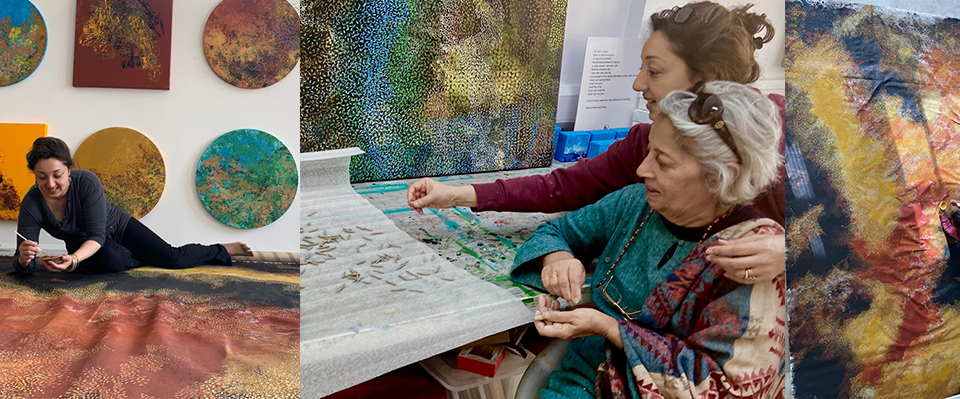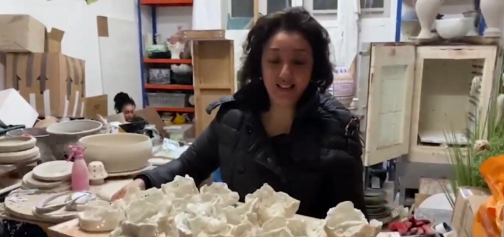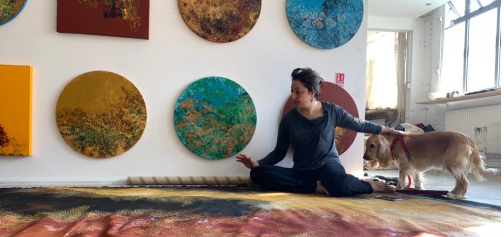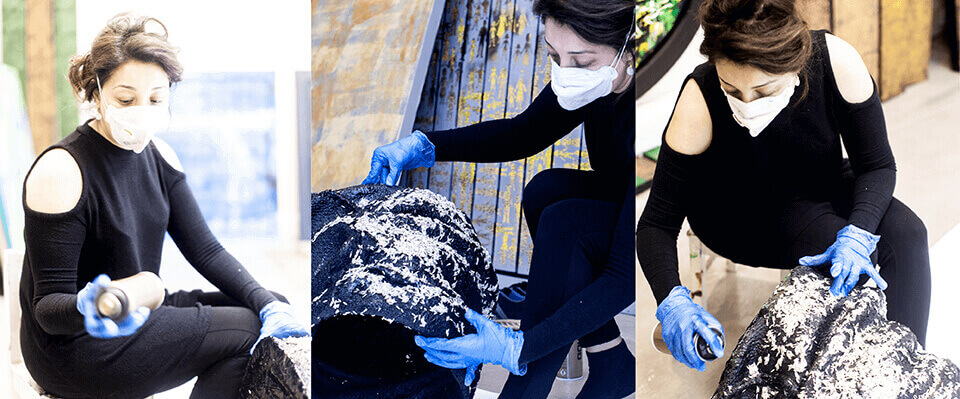ARTIST STATEMENT
My work finds its verse in memories of my days at my grandmother's tea estate, nestled between the mountains in a tiny village called Darang, in Kangra, Himachal Pradesh, a state in Northern India.
It is my spiritual home that renders my aesthetic.
It is my spiritual home that renders my aesthetic.
One of the most important concepts ingrained in me from my wandering days in the hills is that of freedom. Freedom from dogma and religion, freedom from closed mindedness, freedom to choose my influences, and freedom from fitting in.
I don’t believe as a creative person one has a single style through all of one’s works.There is an ever-present desire to evolve and learn and hence a continuous evolution of style.
Layers of surfaces give meaning to the depth of understanding and emotion below. Nothing is ever in a vacuum and nothing is ever truly lost. Even if it can no longer be seen, it is right there under the surface. My works are made up of these layers. Sometimes many layers that you only catch a glimpse of how the work started and how it evolved. The process is what is important for me. No painting is ever finished, like nature is never finished. It grows and collapses and gives of itself time and time again. Every time you look to a landscape you may think nothing has changed and yet... little buds emerge, flowers wilt, foliage matures and there’s something new just waiting to blossom. Change is the only constant. I want my paintings to evoke that feeling, look closely and you see something new everyday, something you hadn’t noticed before, something subtle but present nonetheless. Something now but also of the past and of the future.
I think we all need a purpose greater than ourselves to live up to. For me it’s a reverence for the earth.
A world so tender and fragile and simultaneously strong and insurmountable. I want to capture that in my works. I want it to have a vulnerability and yet be incredibly powerful.
My love affair with the pottery first began when I was 14. That summer, I lived with and learned from the great potters, Mini and Mary in an artists village called Andretta in Himachal. I spent hours turning the wheel with my foot and creating little pieces of magic from the earth. The rest of my time I spent walking around the fields on my own. I didn’t realise it then but I was hooked for life.
After my BFA at Delhi college of art, I’ve done years of painting and installation work. First as a portrait artist and then a figurative artist. Then giving into the Vibrant chaotic landscapes that dotted the cities I lived in, depicting the contrasts and the drama. The energy and life that throbbed through it. A visual tsunami of cityscapes slowly gave way to abstract earthy landscapes. It’s almost like it’s taken me 20 years to finally come home. To understand and know who I am at my very core.
The mountains keep calling out to me. I close my eyes and transport myself to a place of solitude. A place where I was born and reminds me time and time again of who I am when I’m lost. Where there is only quiet and truth. In the stillness, I find all my answers.
The clear air, the blue sky, the beautiful light, the sounds, the colours, the spectacular landscapes, it inspires me to create from nature.
Away from the chaos of city life, the fragrance coming from the winding little paths of freshly wet earth after a torrential shower. The streams gurgling away sometimes so clear that you can see the stones and moss and twigs below, if you are lucky tiny little baby fish and dragon flies and sometimes rough and angry and muddy taking with it everything in its path.
The leaves sometimes rustling in the breeze catching the sunlight and looking like a million stars in bright sunshine and sometimes throwing themselves at you with such power that you feel like you are being slapped by the wind.
The endless fields of golden crops, the lush green carpets of the tea bushes, the soft touch of baby saplings and the fragrance of hundreds of plants growing together.
And one tumultuous shower or forest fire later and everything’s finished. Months of hard work all gone to naught. But in that emptiness also a feeling of being full.
And a submission to the power of nature. A reverence and an understanding that what comes must go, what grows must die and in that there is a rhythm that we cannot deny.
I let what happens on the canvas happen, I have an idea of what I want to do and the colours and mood I want to evoke, the message I hope to convey and then something happens that completely changes the course of the work and I submit to it, I let it flow... it knows more than I do. Everything is in duality. Everything a contradiction. And yet everything in harmony.
I love color, for the first time, I’m making my own colours using natural pigments and glues. Stunning lapis lazuli and beautiful malachite, earthy raw sienna and brilliant yellow. The colours make me wild. I love the lushness and the strong sensual experiences it evokes in me. For me colour is a flavour, it has a fragrance, a meaning, an effect. I love the deep contrasts that take my breath away. I don’t want to be bound by a particular style or medium and there is a synchronicity that speaks through all my works. It’s the essence of my being. But more than everything, I love the light. I love the soft white light of the early morning sun, the strong scorching light of the afternoon sun and warm loving glow of the setting sun. I love how it transforms everything it touches, making even a tiny grain, a little leaf or a mound of earth so precious. I love the play between light and darkness. There is a depth and layering that go far beyond.
You don’t grow on a defined path, you need heart break and pain with strife to help you transform yourself and once you get on the other side of it without becoming hard and staying kind you learn a little bit more about life. To grow and to improve you have to be there at the edge of uncertainty. To not know but to somehow believe. I believe art has power. I believe it has love, strength and passion and it has the ability to transform.
I have a strong desire to be ethical in the implementation of my work, to not succumb to what is expected but to be courageous and have the integrity to do what I believe in. I have to chart my own path, I have to find my own way, my own language. And this I found in the language of grains, the language of food, the language of hunger and that of abundance, it’s the language we all speak despite our differences in race, colour, class or religion. It is these differences that make life colourful. It is in the contrasts that light shines even brighter. It is a language that needs no explanation, It is the oldest language in the world.
It reminds me time and again that despite the contradictions, in essence, we are one








